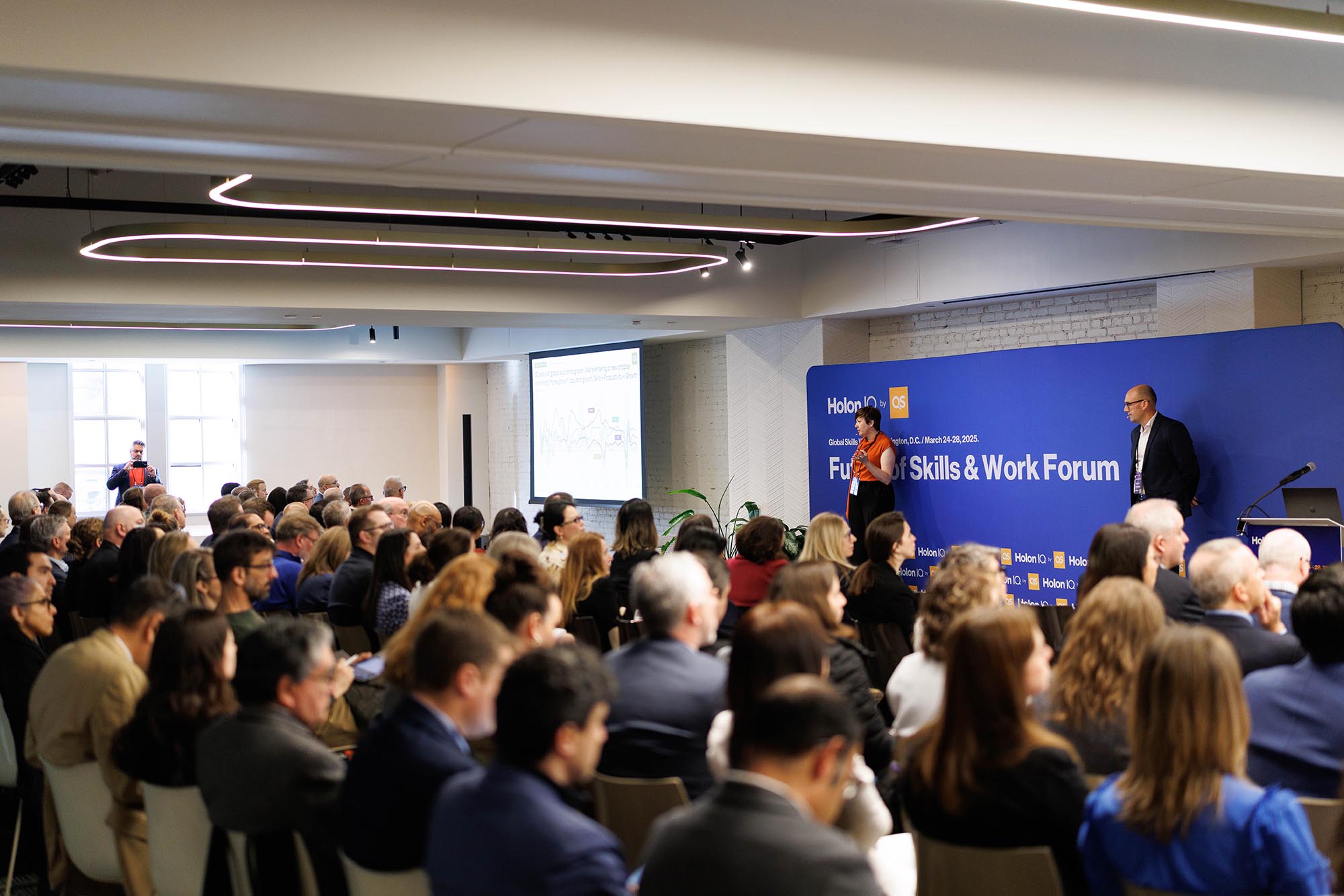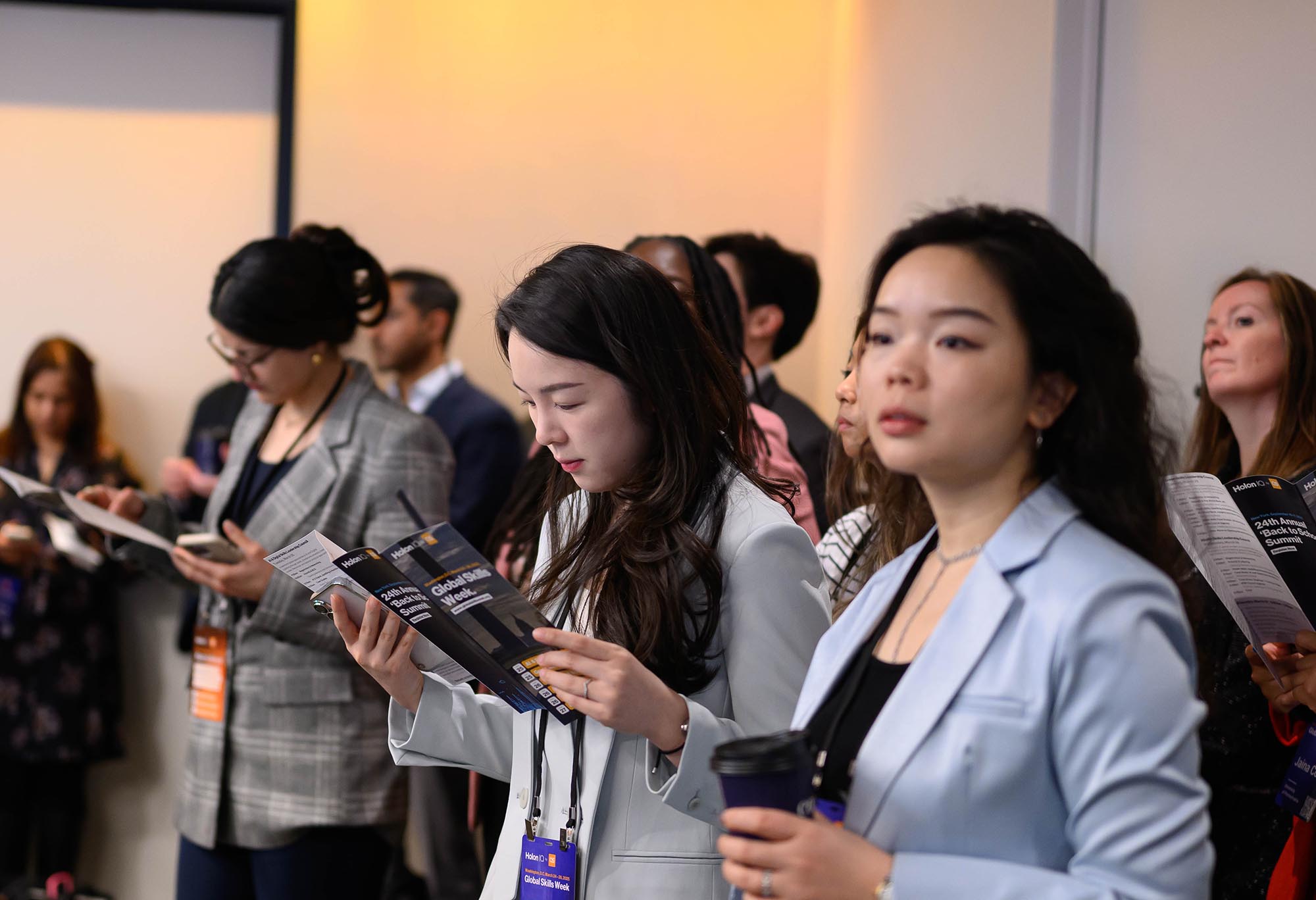Global Skills Week 2025, convened in Washington, D.C. from March 24 to 28, served as a pivotal gathering for leaders across sectors to address the evolving demands of the global skills economy. Bringing together over 350 participants from government, higher education, industry, technology, philanthropy, and economic development, the event provided a collaborative platform to explore the future of work, education, and workforce innovation.
Global Skills Week stands as an important forum for stakeholders committed to shaping the future of the global skills economy and advancing ideas, initiatives, and partnerships that foster next-generation skills, quality employment opportunities, and sustainable economic growth. Through a series of practical workshops, leadership councils, and thought-provoking sessions, participants co-created strategies to bridge the gap between education and industry, foster innovation, and address emerging workforce needs.
The 2025 summit highlighted the necessity of cross-sector collaboration in workforce development - highlighting the vital role of higher education, technology, and policy in equipping individuals with the skills needed for success in an evolving global economy.
Foreword
We are delighted to share this report, developed with the assistance of AI, as a reflection and summary of the 2025 Global Skills Forum held on March 25 as part of Global Skills Week in Washington, D.C. This pivotal event convened a global network of leaders from industry, higher education, technology, policy, and economic development to explore the evolving landscape of skills, work, jobs and economic opportunity.
Global Skills Week stands as an important forum for stakeholders committed to shaping the future of the global skills economy and for advancing ideas, initiatives, and partnerships aimed at fostering next-generation skills, quality employment opportunities, and sustainable economic growth.
Through a series of practical workshops and thought-provoking sessions, participants collaborated to ideate strategies that bridge the gap between education and industry, fostering innovation and addressing emerging workforce needs.
The themes of Global Skills Week addressed the urgent challenges of a rapidly evolving workforce, the potential of advanced technologies and the critical role of the education system to bridge skills gaps, emphasising:
- Career Readiness & Navigation: Leveraging real-time data and digital tools to empower learners in skill identification, program choice, and career planning.
- Transforming Higher Education for the Skills Economy: Highlighting how institutions are reengineering to set their students up for success in the workforce of the future.
- AI & Digital: Showcasing practical, hands-on applications of AI in education and career readiness, from generative AI workshops to institutional strategies for responsible and ethical AI adoption.
- Workforce Alignment & Employer Engagement: Bridging the gap between education and employment via employer-led strategies that validate and align workforce skills.
- Global Talent Pipelines & Mobility: Analysing how international education and migration policies shape national competitiveness, focusing on high-demand fields.
- Critical Industry Skills: Focusing on essential skills in sectors like advanced manufacturing, green skills, healthcare.
We extend our gratitude to our partners, sponsors, and collaborators, particularly American Student Assistance (ASA), Western Govenors University (WGU), Amazon Web Services (AWS), Jobs for the Future (JFF), InSpring, Intel, OpenAI, BCG, America Succeeds, UNCF, IFC World Bank,1Mentor, Shorelight, Pearson, and University of Virginia. Their commitment and support were instrumental in the success of Global Skills Week.
As we reflect on the insights and connections forged during this week, we are reminded of the collective responsibility to drive innovation and equity in the global skills economy. We look forward to continuing this vital work together.
Written by Dr. Maria Spies (Co-Founder, HolonIQ) & Patrick Brothers (Co-Founder, HolonIQ)
Opening Plenary: Connecting the Global Skills Economy
Global Shifts & Demographic Trends
The presentation begins with an overview of extensive global shifts that are reshaping power dynamics, economies, resources, energy, and societies. Population growth - particularly the dramatic increase over the last 500 years - is emphasized as a central driver. Yet, these changes are uneven: while Asia’s numbers may rise until 2030–2050 and then decline, Africa is experiencing an explosive growth, and regions like Europe, Latin America, and North America remain largely flat. Visualizations highlight age-based population trends, where globally, the proportion of individuals aged 80+ will increase dramatically (by sevenfold) and those aged 60–80 will double. In contrast, the younger age brackets (0–20 years) are projected to decline significantly (up to 800 million fewer globally). The United States faces similar challenges with a steep rise in its senior population (80–100 years growing fivefold), underscoring the pressing need for upskilling and reskilling to maintain productivity and labor force participation in an aging society.
Economic Landscape & Workforce Productivity
The narrative shifts to the changing global economy. The engines of economic growth are evolving; emerging markets like China and India are positioned to potentially outpace traditional Western economies. Amid these transitions, many countries are increasingly focusing on home-grown jobs rather than global cooperation. In the United States, about 30% of the working-age population is not active in the labor force, necessitating efforts to boost labor participation and productivity. By contrast, India already shows over half of its working-age population engaged in the workforce. Overall, economic prosperity in the coming decades hinges on the ability to elevate skills and productivity through strategic upskilling and reskilling initiatives.

Jobs and Skills Taxonomy
The presentation outlines a comprehensive taxonomy for segmenting jobs and understanding labor market trends. This classification system encompasses several categories, including people-focused industries (education, healthcare), environmental sectors (agriculture, energy, infrastructure), technology, and consumer-oriented roles. By breaking down the U.S. labor force across approximately 2,000 occupations, data reveal profound shifts over the last 50 years. Some sectors, such as private education and healthcare services, have seen significant growth, while traditional manufacturing has contracted despite overall population increases. This taxonomy not only captures where workers are employed today but also informs how skills and workforce needs will evolve in different geographic and industry contexts.
Artificial Intelligence and Technological Impact
Artificial intelligence (AI) emerges as a dominant theme, recognized as both a threat and an opportunity. Countries worldwide are prioritizing AI capability as a national imperative. Diverse metrics - ranging from R&D investments to AI skill penetration - help map out the AI readiness of different regions. In the U.S., assessments across 2,000 occupations indicate that approximately 2.5 million jobs are highly vulnerable to AI disruption, though there is significant potential for AI to augment existing roles, particularly in technology-heavy sectors. The analysis extends to industry-specific impacts: while technology sectors show high augmentation potential, industries such as construction and certain public sector roles demonstrate lower susceptibility to AI-driven change.
Upskilling, Reskilling, and Lifelong Learning
The final segment stresses the critical need for upskilling and reskilling. With a recent infusion of nearly $500 billion in capital directed toward digital and AI-focused training initiatives globally, the traditional education landscape is rapidly evolving. Universities are increasingly embracing non-degree credentials and micro-credentials, and projections suggest these awards may soon dominate over traditional degrees in the U.S. Moreover, career navigation support is gaining prominence, helping learners - from high school students to lifelong professionals - navigate complex educational pathways and rapidly shifting job requirements. This ecosystem, encompassing skill recognition, digital learner experience, and data-driven evaluation, is becoming essential for securing economic strength and ensuring that both individuals and nations remain competitive as innovation accelerates at unprecedented speeds.
Opening Panel: The Future of Skills and Economic Opportunity
Speakers:
- Julie Lammers (Executive Vice President at American Student Assistance)
- Maria Flynn (President and CEO at Jobs for the Future)
- Ted Mitchell (President at the American Council on Education)
- Maura Polly (Executive Director at Blackstone Charitable Foundation)
Summary: Evolving Workforce Dynamics and the Shift Toward Skills-Based Education and Hiring
The panel discussion, with speakers from the Blackstone Charitable Foundation, the American Council on Education (ACE), Jobs for the Future (JFF), and American Student Assistance (ASA) illuminated the transformative shift underway in the U.S. workforce and education ecosystem. The dialogue underscored the urgency of moving beyond degree-centric paradigms toward a skills-based model of education, employment, and economic mobility. Several interrelated themes emerged, including employer demand for demonstrable skills, the evolution of higher education, systemic challenges in credentialing, and the importance of early and ongoing career readiness.
Employer Perspectives: A Panoramic View from Industry
The panel opened with a macroeconomic overview from Maura Pally, Executive Director of the Blackstone Charitable Foundation, which manages a global portfolio spanning more than 230 companies and 700,000 employees. The moderator emphasised that workforce needs vary dramatically across sectors - whether in data centers, food services, infrastructure, or education technology. Blackstone’s workforce development initiatives, such as its Launchpad program for first-generation and low-income students, reflect the growing private-sector recognition that traditional degrees are no longer sufficient indicators of job readiness. Increasingly, employers are prioritizing adaptability, real-world problem-solving, and demonstrable skills over academic pedigree.
Higher Education’s Response: Embedding Skills into Traditional Pathways
Ted Mitchell, President of ACE, acknowledged criticism that higher education has become detached from workforce needs. Nevertheless, he highlighted promising reforms such as partnerships with tech firms - e.g., the University of Texas integrating Google and Coursera certificates into credit-bearing programs. This “bolt-on” model enhances traditional degrees with market-relevant competencies. Mitchell further noted the reorganization of the Carnegie Classification system and the potential of AI to map course-based skills to job requirements. These developments aim to transform academic transcripts into skills-based records that are legible to employers, signaling a shift from degree inflation to skill articulation.
Nonprofit Advocacy: Skills-First Hiring and Cultural Transformation
Maria Flynn, President & CEO of JFF presented stark labor market disparities: only 38 million out of 160 million U.S. workers from historically marginalized groups currently hold quality jobs. JFF’s objective is to raise this figure to 75 million by 2033. Flynn noted a persistent misalignment between executive-level commitment to skills-first hiring and the practices of frontline hiring managers, many of whom continue to default to degree requirements. The joint JFF-ASA “Degrees of Risk” report highlights hiring inertia and risk aversion toward nontraditional candidates. Flynn called for a systemic “rewiring” of hiring and promotion practices to align with inclusive, competency-based frameworks.

Early Career Readiness: Intervening Before Post-Secondary Education
Julie Lammers, Executive Vice President of ASA advocated for introducing career readiness initiatives as early as middle school. She stressed that waiting until college to expose students to career pathways overlooks critical formative years. ASA promotes work-based learning and experiential opportunities during high school, emphasizing their influence on lifelong trajectories. However, she observed that most K–12 systems are ill-equipped to support the shift toward a skills-based economy, resulting in a disconnect between early education and workforce demands.
Systemic Challenges in Credentialing and Skill Navigation
A key theme in the extended discussion was the difficulty learners face in navigating the fragmented credential landscape. According to Credential Engine (2023), the U.S. offers over one million distinct credentials, many lacking transparent quality indicators. This surplus has created confusion among both learners and employers. ASA and JFF’s research finds that 65% of young people are interested in non-degree pathways, but fear of failure and lack of trusted guidance push them toward conventional routes. To address this, initiatives like ASA’s Career Navigation program and JFF’s employer engagement strategies aim to enhance transparency and accessibility in career preparation.
Partnerships and Institutional Innovation
Institutions are experimenting with innovative models through peripheral structures or “skunkworks” that can circumvent traditional academic bureaucracy. Examples include Coursera collaborations, Harvard Extension School, and the U.S. Chamber of Commerce’s EPIC project, which links K–12 education with industry through real-world learning challenges. These efforts represent early prototypes of a demand-driven, collaborative education-to-employment ecosystem.
The Role of AI and Digital Equity
AI emerged as both a catalyst and a concern. While AI can streamline hiring, personalise learning, and identify hidden skills, it also risks exacerbating digital divides. Anecdotes from classrooms- such as middle school teachers avoiding technology due to fears of AI misuse - illustrate the sector’s lack of readiness to harness its benefits constructively.
Conclusion: Toward an Integrated, Equitable Ecosystem
The discussion culminated in a consensus that the dichotomy between degrees and skills is outdated. Instead, the future lies in integrated models that elevate skills while embedding them into traditional learning pathways. Success will depend on the alignment of policy, institutional practice, employer engagement, and learner support. Until then, many students will continue to navigate a complex and opaque system with limited tools, perpetuating inequities and underemployment. The panelists called for urgent action - anchored in collaboration, innovation, and equity - to translate decades of discourse into tangible, systemic change.
Policy Landscape for Skills-First Initiatives
Speakers:
- Karishma Merchant (Associate Vice President, Policy & Advocacy at Jobs for the Future)
- Taylor Maag (Director of Workforce Policy at Jobs for the Future)
- Amanda Winters (Program Director of Postsecondary Education at National Governors Association)
- Brianna McCain (Vice President at JPMorganChase Policy Center)
Introduction and Session Overview
The session commenced with Karishma Merchant introducing herself as the Associate Vice President of Policy and Advocacy at Jobs for the Future (JFF) and introduced her colleague, Taylor Maag, Director of Workforce Policy for JFF. The panel also included Amanda Winters from the National Governors Association and Brianna McCain from JP Morgan Chase.
JFF’s Role and Policy Priorities
Karishma outlined JFF’s strategy, noting that the organization had been driven by insights from workforce boards, employers, community colleges, and education training providers. She stressed that policy reform at the federal level was essential for ensuring that non-partisan, practice-informed solutions reached all areas of the education-to-careers continuum and provided key insights from recent research that showed key policy areas - such as career preparation, expanded economic opportunities, apprenticeship programs, and childcare affordability - received strong bipartisan support. Skills-based hiring, which had reaffirmed the need for policies that directly connected workforce development with career pathways was also strongly backed.
Federal Policy Outlook and Legislative Dynamics
The discussion had then moved to the federal policy outlook. The speakers had observed that the U.S. Congress, now tightly divided with a strong Republican majority in both the House and the Senate, had limited legislative flexibility. The panel had explained that traditional congressional channels for passing comprehensive legislation had been constrained by the 60-vote threshold in the Senate, leading to greater reliance on budget reconciliation as a tool for advancing policy changes. Karishma had outlined several fiscal topics on the docket for the year, including debt ceiling negotiations, the expiration of tax cuts from President Trump’s first term, and proposed spending adjustments in Medicare, Medicaid, border security, and energy. Additionally, she had noted that critical legislative priorities - such as the reauthorisation of the Workforce Innovation and Opportunity Act and the expansion of Workforce Pell for job training - had been championed by key figures in the administration and were under active review.
Emphasis on Cross-Sector Collaboration and Best Practices
Speakers stressed that the development of effective skills-first policies was not a siloed endeavor, underlining the importance of forging partnerships among federal and state governments, employers, and educational institutions. Amanda had described how the National Governors Association had supported states in exploring skills-first approaches, noting that multiple governors had issued executive orders aimed at eliminating the bachelor’s degree requirement for public sector roles. She highlighted that though states defined “skills-first” differently, common themes such as data modernization and enhanced alignment between curricula and employer needs had emerged. Peer-to-peer learning had been instrumental in disseminating best practices and avoiding policies that had failed elsewhere.
Brianna McCain complemented these insights by outlining JP Morgan Chase’s strategies for engaging diverse talent and upskilling its workforce, referencing emerging talent programs, continuous educational funding for employees, and advocacy for streamlining apprenticeship regulations across states as integral to bolstering the talent pipeline for high-quality jobs.
Concluding Remarks and Key Policy Recommendations
In closing, the panel distilled the discussion into three critical themes: the necessity of cross-sector and cross-level collaboration, the crucial need for data modernisation in state systems, and the momentum underlying the skills-first agenda. Both Amanda and Brianna agreed that, if given the opportunity to wield a “magic wand,” they would prioritise policies that modernised data systems and better aligned educational curriculum development with the concrete needs of employers.

The Workforce Equation: Balancing Skills Development and Job Requirements
Speakers:
- Kennon Harrison (Head of Corporate Workforce Partnerships at ETS)
- Kristina Francis (Executive Director at JFFLabs)
- Matt Gee (Director, U.S. Programs Data at Gates Foundation)
- Simone Rodriguez (Chief of Staff to the CEO at Cognizant)
Introduction and Session Context
The moderator, Kennon Harrison from ETS, introduced himself as a leader of corporate workforce partnerships with a global presence and emphasised the importance of providing better information about skills to various stakeholders - including individuals, businesses, workforce organisations, governments, and educational institutions. He stressed that a true skills-based ecosystem depended on network activation, data transparency, catalytic capital, and employer engagement.
Panelist Introductions
Kristina Francis, Executive Director for JFF Labs, shared that she led the innovation and experimentation arm at Jobs for the Future (JFF) Kristina underscored the critical objective of JFF: to identify 41 million Americans (on top of the 38 million already in quality jobs) without a college degree and guide them toward quality employment. Matt Gee then provided insights from the Gates Foundation, where he directed efforts focused on leveraging data and AI across educational and workforce programs. Finally, Simone Rodriguez, Chief of Staff to the CEO at Cognizant, explained that Cognizant was a global IT services company employing over 335,000 associates worldwide and that learning and development formed a core part of their business model.
Framing the Discussion Around Skills Gaps and Data Insights
The moderator reiterated that the session aimed to identify the gaps in the education-to-workforce continuum, discussing not only the challenges of talent shortages and skills mismatches but also how data-driven insights could offer solutions. Kristina explained that while there were several initiatives tackling different aspects of the problem - such as mapping talent and job matching - one significant challenge remained: the lack of an interoperable platform that integrated all stakeholder perspectives. She noted that it was essential to address how individuals, employers, and educational institutions could better align when validating and verifying skills. Moreover, she stressed the need to “de-risk” the process for millions of learners by using emerging technology and AI-driven decision-making tools. This approach was intended to support better data analysis that translated into actionable interventions for workforce and postsecondary educational settings.
Industry Perspectives and Practical Examples
Simone provided concrete examples from Cognizant’s internal initiatives. She discussed how Cognizant leveraged its talent intelligence platform - known as “My Skills” - to dynamically update its learning curriculum based on real-time data from both internal and external sources. This platform allowed Cognizant to anticipate emerging market trends and adjust training programs accordingly. Simone noted that while high-performing technical staff experienced modest productivity increases with AI support, lower-performing staff saw much larger gains. She emphasized that the major challenge lay in measuring and nurturing soft skills - critical thinking, innovation, self-awareness, grit, and perseverance - which were not as easily quantified but essential for long-term career advancement.
Matt reinforced the value of using AI for translating unstructured, multimodal data (such as video content) into structured insights. He highlighted partnerships with research institutions, which aimed to better assess “durable skills” and ultimately enhance each employee’s self-perception and efficacy.
Future Directions
In conclusion, the panel emphasized that solving the education-to-workforce gap required a collaborative and data-rich approach that integrated emerging technologies with robust analytical frameworks. They agreed that aligning technical skills training with critical soft skill development was essential for driving upward mobility and enhancing organizational performance. The discussion underscored that fostering innovation, ensuring data interoperability, and establishing strong public - private partnerships were key to transforming workforce development and tackling deep-seated talent shortages.
Future of International Education & Global Talent Pipelines
Speakers:
- Dominic Berardi (Vice President, Government Affairs at Shorelight)
- Rebecca Peters Corley (Director, Semiconductor Public Policy at Samsung Electronics America)
- Matteo Quacquarelli (Vice President, Strategy & Analytics at QS Quacquarelli Symonds)
Introduction and Session Overview
The moderator opened the session by welcoming the audience and emphasising that, after an intense three hours of discussion, a new panel was about to begin just before lunch. The focus was set on the future of international education and global talent pipelines, with a particular lens on addressing high-skilled talent shortages in the United States. The moderator explained that the conversation was to be steered from an industry perspective, rather than solely through the traditional higher education lens, as international student mobility and global recruitment strategies were central to closing the skills gap in the domestic market.
Moderator and Panelist Introductions
Matteo Quacquarelli, Vice President of Strategy and Analytics at QS, assumed the role of the moderator. He presented QS’s longstanding support for higher education institutions in areas such as performance, research, reputation, and international recruitment. Matteo highlighted that QS had worked with over 7,000 institutions worldwide and engaged tens of millions of prospective international students every year. He also mentioned the launch of the World Future Skills Index, which underscored the connection between workforce development and international education. Following his introduction, Matteo invited the panelists to introduce themselves.
Rebecca Peters Corley, a Director of Semiconductor Public Policy at Samsung, provided an industry perspective. She recounted Samsung’s history in the US, noting that the company had been the first foreign national semiconductor manufacturer in Austin in 1996, and since expanded its investment substantially - including recent large-scale investments in Texas driven by the Chips and Science Act. She stressed that Samsung’s initiatives had been instrumental in creating thousands of jobs in the semiconductor sector, which had been facing significant talent shortages.
Matteo then turned the floor to Dominic Berardi, Vice President, Government Affairs at Shorelight Education, who emphasised his company’s role in facilitating international student mobility. Dom recalled that Shorelight successfully brought over 25,000 students to the United States and built partnerships through the coalition, Compete America, which joined industry and higher education to address America’s strategic competitive challenges in talent pipelines.

Setting the Stage with Data and Global Trends
The moderator laid out a macro view of the talent landscape by presenting key data points. He shared that by 2030, an estimated 85 million jobs worldwide were predicted to go unfilled, which represented a potential $8.5 trillion revenue risk for global companies. He underscored that talent shortages were particularly acute in the US, where 70% of firms reported difficulties in identifying the appropriate talent to fill open vacancies. In addition, the panel discussed domestic demographic trends - including a decline in the young population in the US over the next 75 years - and contrasted these trends with international student mobility metrics. For example, QS data indicated that the average US institution hosted merely around 2,900 international students per year compared with higher figures in countries like the United Kingdom.
Industry Perspectives on Talent Pipelines and Solutions
Rebecca then provided a detailed industry outlook from the semiconductor sector. She noted that, following the enactment of the Chips Act, the semiconductor industry invested about $550 billion in the United States, resulting in tens of thousands of direct operational and construction jobs. However, she highlighted that the industry had faced a shortage of skilled workers - especially in STEM fields - with an estimated deficit of 1.4 million qualified professionals in science, technology, engineering, and maths, which directly impacted hiring in critical roles such as engineering and computer science. Rebecca also discussed short-term and long-term solutions, emphasising the importance of immigration as a stopgap measure given that a significant portion of STEM graduates in the US had been foreign nationals. She outlined efforts to invest in domestic workforce pipelines, including scholarships, upskilling programs, and partnerships with local educational institutions.
Dom elaborated on the evolving global mobility of skilled talent, noting that while the United States still attracted a considerable number of international students, its share of globally mobile talent had declined relative to traditional English-speaking destinations. He stressed that this trend highlighted the need for immigration reforms and clearer pathways for high-skilled talent, with the industry urging policies that would fast-track green cards for individuals with advanced STEM degrees.
Policy Discussion and Concluding Remarks
The panel then shifted towards policy considerations, as questions from the audience had sparked discussions on developing AI-based skills matching systems and improving the connection between educational curricula and industry needs. The panelists debated the merits of a national skills matching application, citing the current mismatch between job descriptions and actual skill requirements. They concluded that cross-sector collaboration, effective data modernisation, and improved immigration policies were essential to bridge the gap between education and workforce outcomes. The session wrapped up with final remarks emphasising the urgency of these policy interventions, as well as the potential benefits of aligning international education strategies with domestic labor market needs.









.jpeg)









